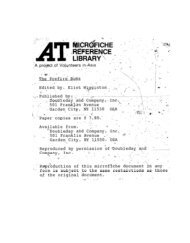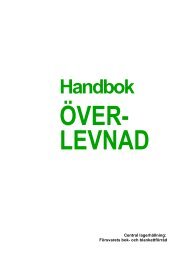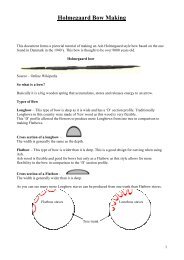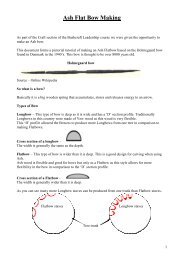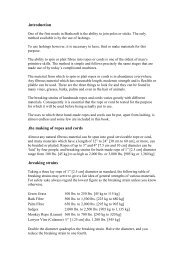Experiments on Knife Sharpening John D. Verhoeven ... - BushcraftUK
Experiments on Knife Sharpening John D. Verhoeven ... - BushcraftUK
Experiments on Knife Sharpening John D. Verhoeven ... - BushcraftUK
Create successful ePaper yourself
Turn your PDF publications into a flip-book with our unique Google optimized e-Paper software.
[4] Hand <strong>Sharpening</strong> with Flat St<strong>on</strong>es and Leather StropsAll of these experiments were carried out <strong>on</strong> the stainless steel blades of Fig. 5with the T edge resharpened <strong>on</strong> the Tru H<strong>on</strong>e sharpening machine using either the 600 or1000 grit wheels. This process, described in more detail above, produced a 2β edge angleof essentially 39 o <strong>on</strong> the 600 wheels and 41 o <strong>on</strong> the 1000 grit wheels. The blades werehand sharpened <strong>on</strong> various media to be described below with the aid of the Razor Edgesharpening holder shown in Fig. 21. The value of the 2β edge angle was c<strong>on</strong>trolled byadjusting the distance the blade extended into the holder. The value was measured with aprotractor jig and checked <strong>on</strong> ground blades with the laserdevice described in App. 1. The Razor Edge holder wasset to produce a 2β edge angle of 48 o , giving an edge anglethat was 9 o larger than the as-ground edge angle of the 600grit blades and 7 o larger than the 1000 grit blades. Thisincrease in 2β ensured that the acti<strong>on</strong> of the handsharpening occurred uniformly al<strong>on</strong>g the cutting edge ofthe as-ground blades.After some experimentati<strong>on</strong> the method of hand sharpening shown in Fig. 22 wasadopted. An alternate 4 stroke cycle was used. On the first stroke the blade was runacross the st<strong>on</strong>e or leather to the right with orientati<strong>on</strong> A. The holder was then flippedover and the opposite face run across to the right in orientati<strong>on</strong> B. The procedure wasthen repeated for orientati<strong>on</strong>s C and D with the stroke nowgoing right to left. This procedure alternated the abrasive acti<strong>on</strong>between opposite faces and <strong>on</strong> each face produced abrasi<strong>on</strong> inalternating directi<strong>on</strong>s. In all cases for leather stropping thestroke moved the blade in a directi<strong>on</strong> away from the edge, Adirecti<strong>on</strong> of Fig. 3. For hand sharpening <strong>on</strong> st<strong>on</strong>es, however, thedirecti<strong>on</strong> of the strokes relative to the blade edge, either A or Idirecti<strong>on</strong> of Fig. 3, were varied as will be discussed below.A B D CDirecti<strong>on</strong> of strokesFigure 22 Blade orientati<strong>on</strong> and directi<strong>on</strong>of stroke during hand sharpening.<str<strong>on</strong>g>Experiments</str<strong>on</strong>g> d<strong>on</strong>e with sharpening st<strong>on</strong>es A series of experiments was carriedout in which the c<strong>on</strong>trol stainless steel blades were hand sharpened <strong>on</strong> the following 3different st<strong>on</strong>es and the diam<strong>on</strong>d h<strong>on</strong>e:1- Suehiro Deluxe 6000-3, a 6000 grit waterst<strong>on</strong>e2- Kitayama Super Polish St<strong>on</strong>e, a 8000 grit waters<strong>on</strong>e.3- Ultra fine h<strong>on</strong>e from Razor Edge, a dry st<strong>on</strong>e.4- DMT SuperH<strong>on</strong>e Kit, a 1200 grit diam<strong>on</strong>d h<strong>on</strong>e.The first 2 st<strong>on</strong>es are Japanese waterst<strong>on</strong>es which were used in the wet c<strong>on</strong>diti<strong>on</strong> andprec<strong>on</strong>diti<strong>on</strong>ed with a Nagura st<strong>on</strong>e following the recommended procedures suppliedwith the st<strong>on</strong>es. The 3rd st<strong>on</strong>e was a c<strong>on</strong>venti<strong>on</strong>al ceramic st<strong>on</strong>e used dry asrecommended by the supplier, Razor Edge. The diam<strong>on</strong>d h<strong>on</strong>e was the type with thediam<strong>on</strong>d embedded in a nickel matrix <strong>on</strong> a perforated steel plate.18



